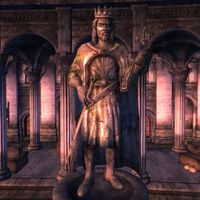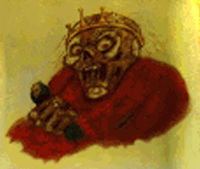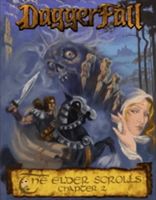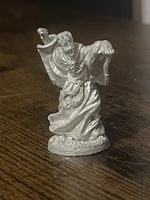Lore:Underking
| The Underking | |||
|---|---|---|---|
 The Underking
The Underking |
|||
| Race | Unknown | Gender | Male |
| Appears in | Daggerfall | ||
The Underking (sometimes UnderKing), or the Evil One, was a mysterious figure of myth and legend, known throughout Tamriel in the Third Era (and by some accounts, even earlier).[1][2][3] His legions of living and undead followers were called his Agents, and he was known to be opposed to Mannimarco, the King of Worms and his cult of necromancers.[1]:50[2] The Underking was one of seven factions in the Iliac Bay region that played a major role in events preceding and during the Warp in the West in 3E 417.[2]
The Underking was the "old bugbear" of fairy tales dating back to the earliest years of the Septim dynasty. Some tales described him as a very old, very powerful lich—or at least, something resembling one. Others claimed he was the most powerful mage who ever lived. Somehow, this mage "lost his heart" and his very being was transformed. The mage's heart "disappeared", and without it, the Underking could not truly live or die.[1][4]
The stories were largely true, though the Underking's identity remains a matter of dispute. Most sources (notably, the Underking himself)[5] claim he was once Zurin Arctus, Battlemage of Emperor Tiber Septim.[2] Zurin also went by his Breton name Arnand the Fox.[6][7] As the Underking, Arctus has been associated with Magnus, the god of magic,[8] and was stated to be the most powerful mage to ever live.[4] However, according to The Arcturian Heresy the Underking was Ysmir Wulfharth, a supernatural being said to have lived many lives, and who was an ally of Tiber Septim. Among Wulfharth's numerous purported titles was "Underking".[3] The King of Worms was also rumored to be the Underking.[9]
Contents
History[edit]
Second Era[edit]
There are differing accounts of the Underking's origin, though the stories share some similarities:
Zurin Arctus[edit]
The Second Era saw Emperor Tiber Septim wage a series of wars with the goal of conquering or otherwise pacifying all of Tamriel.[10] At his side was the Imperial Battlemage Zurin Arctus.[2] The final years of the era saw the Empire turn its attention to Morrowind. Rather than wage war, the Tribunal signed an Armistice. While the exact terms were never disclosed, it was speculated that the living god Vivec agreed to give the Empire Numidium[11]—a colossal brass golem created by the Dwemer[2][12][13]—to aid in conquering the Summerset Isles.[11] It was further speculated that Zurin Arctus played a major role in brokering the Armistice.[11]
With the power of Numidium, the Empire could easily conquer the Second Aldmeri Dominion, but there was a problem: Numidium would not function.[14] By Tiber Septim's order, Zurin Arctus crafted a magical artifact that gave its bearer the power to control the Empire's new weapon—the Totem of Tiber Septim.[14] The Battlemage also placed a seal on the Totem; anyone not of the Septim bloodline (or at least, a royal lineage) or possessing a particular supernatural quality would be killed if they attempted to use it.[14]
But the Totem was not enough; Numidium lacked a power source. The Dwemer had originally used the Heart of Lorkhan,[3] but this was no longer available.[15] Undeterred, an alternate source of power was devised, a massive green gem known as the Mantella, which was infused with Arctus' own life force.[14] Numidium was reactivated in 2E 896 at Rimmen in Elsweyr,[6] and the Isles were no match for its terrible might; it is said that the siege of Alinor lasted only an hour before the Altmer surrendered.[UOL 1] Tamriel was united, and the emperor declared the beginning of the Third Era beginning the following year.[10]
Tiber Septim betrayed his Battlemage, however.[16] Once the Empire's enemies were defeated, the emperor began using Numidium to crush the neutral royal families of Tamriel and install loyalists. Zurin Arctus, furious at this misuse, fought to reclaim the Mantella. In the battle that followed, both the Battlemage and Numidium were annihilated and the Mantella—their shared "heart"—was blown into the netherworld of Aetherius. The Totem of Tiber Septim was also lost as the remains of Numidium were scattered across Tamriel, and Arctus, cut off from the Mantella, fell into a state of semi-slumber in a subterranean vault somewhere in High Rock.[2][14][17]
As the Third Era progressed, the Empire's elite soldiers—who would come to be known as the Blades—were tasked with collecting the remains of Numidium. Zurin Arctus became known as the Underking, and sent his minions forth to search for the Mantella.[14]
Wulfharth[edit]
Another account claims the Underking was Ysmir Wulfharth, a High King of Skyrim in the First Era, who periodically returned to life at several points in history, and was thought to be a mortal avatar of Shor[UOL 1] (the Nordic version of Lorkhan).[3][8][18] His later incarnation, the Ash-King, is said to have been summoned back to life to fight the Dwemer at the Battle of Red Mountain in the First Era,[3][18] and again to Red Mountain in 2E 572 to repel the Second Akaviri Invasion.[19][20] Some accounts of the latter battle refer to the Ash-King as "the Underking".[3][21]
Wulfharth the Underking was an advisor to and secret magical ally of Hjalti Early-Beard, who would in time become Emperor Tiber Septim. When the emperor turned his attention to Morrowind, the Underking urged him to conquer the land, as Wulfharth had long hated elvenkind. However, the Armistice was signed instead; Wulfharth felt betrayed by the concessions given to the Dunmer and abandoned the Empire. Without the Underking, Tiber Septim abandoned hope of creating a united Tamriel.[3]
Meanwhile, as Numidium now belonged to the Empire, Tiber Septim had Zurin Arctus research it. The Battlemage eventually learned of the Battle of Red Mountain, of Numidium's true purpose and power, and of the Underking's involvement. However, his research was based off incomplete Dwemer plans. Arctus came to the conclusion that Numidium was powered by the "heart" (life force)[5] of Lorkhan's physical body—that is, his mortal avatar, Wulfharth.[3]
Upon hearing this revelation, Tiber Septim realized that with Numidium, he could complete his conquest of Tamriel, and set a trap for Wulfharth. The Underking returned upon being told the emperor had decided to attack the Tribunal after all, but was met by the Imperial guards. A battle ensued, in which Zurin Arctus cast a Soul Trap spell on the Underking. As he died, Wulfharth's "heart" tore a hole through the Battlemage's chest, killing him. The emperor then appeared, collected the soul gem containing Wulfharth's heart (the Mantella), and covered up the incident by claiming Arctus had been killed while attempting a coup. Numidium was then used to conquer Summerset Isle; shortly after the battle, a "rotting undead wizard" appeared and blew Numidium to pieces, though he was then crushed by the golem's death throes.[3]
Third Era[edit]
Aftermath[edit]
Tiber Septim was then crowned First Emperor of Tamriel, and ruled for thirty-eight more years. During his reign, the holy site of Sancre Tor had been overrun with evil. Tiber sent his four mightiest Blade agents to determine what had befell this place. It turned out to be the works of Zurin Arctus, the Underking who cursed the Blades to a permanent undead state in which they guarded the halls of the ruined site as an act of vengeance against Tiber.[22]
Upon his death, Tiber Septim was succeeded by his grandson, Pelagius I, to whom the Underking also appeared, claiming to have been sent by Tiber himself to help the new emperor run his Empire.[3] Under the guidance of The Underking, Pelagius continued his predecessors legacy with the prosperous and great rule of his Golden Age. This was however, cut short when Pelagius was murdered by Dark Brotherhood assassins.[10]
Another event that took place in this early Third Era time period was Zurin enchanting a piece of marvelously crafted Dragon-bone armor as a means of paying off a debt he owed to a traveling warrior.[23] Despite these various deeds, the Underking had expended nearly all of his power in his defeat of the Numidium and was forced to retire to a subterranean vault in High Rock where he could slowly rebuild his strength over many years.[17]
Imperial Simulacrum[edit]
During the Imperial Simulacrum, the Eternal Champion was known to have encountered the Underking's minions, who were described as fanatical and seemingly insane. Of particular note, the Champion was tasked with retrieving a document from the lair of Golthog the Dark, a necromancer rumored to be servant of the Underking in Hammerfell. In return, Queen Blubamka of Rihad assisted in uncovering the location of a piece of the Staff of Chaos.
The Eternal Champion also recovered the Ring of Khajiiti from a crypt in Black Marsh where it had been hidden by the Underking.[24]
The Warp in the West[edit]
In 3E 401, the location of the Mantella was discovered by Nulfaga the sorceress, queen mother of Daggerfall.[25] Around this time, Emperor Uriel Septim VII received word that the Totem of Tiber Septim had also been found.[2][25] In 3E 405, Uriel VII sent an Agent of the Blades to the Iliac Bay region to investigate the death of King Lysandus of Daggerfall, and also to find a missing letter he had written to that kingdom's queen.[2] The Underking figured prominently in many of the events to follow, culminating in the Warp in the West.[26]
Prince Arthago of Sentinel, eldest son of King Camaron and Queen Akorithi, had vanished in 3E 400; a popular rumor was that he had been taken by the Underking.[2][27] Prince Lhotun wanted to know the full story, and hired the Agent to find out more. With the help of the Underking's minions, the Agent was able to uncover the truth—that the king and queen were behind the disappearance.[28] The Agent's work in Sentinel eventually led to being contacted by the Underking to retrieve an item stolen by the King of Worms and his necromancers, which they had cursed and given to the Blades. The Agent was able to infiltrate the Blades' hideout in Ykalon and recover the item before it could bring harm upon the group.[2]
The Agent eventually discovered that King Lysandus had been murdered by Lord Woodborne, a noble from Wayrest, in a bid to attain power—and that he had for some time been in possession of the Totem of Tiber Septim.[2] The Agent then recovered the Totem from the heavily guarded treasury of Castle Daggerfall, which immediately sparked a bidding war between seven major powers of the Iliac Bay (including the Empire) for its possession. The Underking was one of these, and made his offer:
- "Centuries ago, Tiber Septim ruled the land and forged an empire with great Numidium. The secret of Numidium's power lies in its heart, carried within the Mantella. It is the heart of Tiber Septim's battlemage. It is my heart. It is my Mantella. It is my Totem. It belongs to me, and to none other. I have won and lost an empire. I have no desire to tamper further with mortal affairs. I have in my possession Necromancer's Amulet, one of the world's greatest artifacts. You may have it in in exchange for the Totem."[5]
In the end, the Agent gave the Totem to the Underking, then traveled to Aetherius and recovered the Mantella.[29] At the Underking's bidding, Numidium was activated once more; he awoke from his centuries-long sleep, raced across the bay to meet the automaton, and rejoined with his heart in a massive explosion.[29] For a brief moment, he was flesh and blood again, then finally able to attain the true death he had long sought.[29] The destruction of Numidium created an anti-magic zone of several miles radius around the area.[17]
Impossibly, through some sort of time distortion, each of the other six factions simultaneously obtained the Totem as well, and activated Numidium to their own ends. The resulting cataclysm permanently reshaped the kingdoms of the Iliac Bay, and the incident was later dubbed by the Blades as the Warp in the West.[26]
Oblivion Crisis[edit]
In 3E 433, the Hero of Kvatch traveled to the ruins of Sancre Tor in the Jerall Mountains to recover the Armor of Tiber Septim. The ruins had been sealed by the Blades in 3E 36 after four members had gone missing within. Once inside, the Hero encountered the ghosts of the four Blades, who had been cursed by the Underking along with the rest of the ruins. With their help, the Hero was able to break the curse and recover the armor.[30]
Notes[edit]
- The Elder Scrolls III: Morrowind opens with the following quote:
-
- "Each event is preceded by Prophecy. But without the hero, there is no Event."
- — Zurin Arctus, the Underking
- According to an unused rumor, some people believe that Tiber Septim himself became the Underking.[UOL 2]
See Also[edit]
- For game-specific information about the Underking, see the Daggerfall article.
- See the Lore articles about Zurin Arctus or Wulfharth for more information on these individuals.
Gallery[edit]
References[edit]
- ^ a b c Arena Player's Guide
- ^ a b c d e f g h i j k l Events of Daggerfall
- ^ a b c d e f g h i j The Arcturian Heresy — The Underking, Ysmir Kingmaker
- ^ a b Generic dialogue in Daggerfall
- ^ a b c Letter from the Underking during Totem, Totem, Who Gets the Totem? in Daggerfall
- ^ a b Where Were You ... Dragon Broke — Various
- ^ Interview With Three Booksellers — Jobasha, Codus Callonus, and Dorisa Darvel
- ^ a b Varieties of Faith... — Brother Mikhael Karkuxor of the Imperial College
- ^ Quest-related dialogue in Daggerfall
- ^ a b c Brief History of the Empire, v 1 — Stronach k'Thojj III
- ^ a b c On Morrowind — Erramanwe of Sunhold
- ^ Divine Metaphysics
- ^ Baladas Demnevanni's dialogue in Morrowind
- ^ a b c d e f Letters you may receive during The Mantella Revealed in Daggerfall
- ^ Dagoth Ur's Plans — Tribunal Temple
- ^ The King of Worms' dialogue during Soul of a Lich in Daggerfall
- ^ a b c The Elder Scrolls - 10th Anniversary, originally found at Elderscrolls.com
- ^ a b Five Songs of King Wulfharth
- ^ Jorunn the Skald-King — Helgreir Lute-Voice, Bard of Windhelm
- ^ The Second Akaviri Invasion — Yngmaer Raven-Quill, Historian Royal of the Bards' College, Solitude
- ^ Mysterious Akavir
- ^ Ghost of Rielus' dialogue in Oblivion
- ^ Tamrielic Lore — Yagrum Bagarn
- ^ Events of Arena
- ^ a b The Daggerfall Chronicles — Ronald Wartow
- ^ a b The Warp in the West — Ulvius Tero
- ^ Night Falls on Sentinel — Boali
- ^ Death Certificate found during The Missing Prince in Daggerfall
- ^ a b c Journey to Aetherius quest in Daggerfall
- ^ Events of Oblivion
Note: The following references are considered to be unofficial sources. They are included to round off this article and may not be authoritative or conclusive.
- ^ a b Michael Kirkbride's Posts
- ^ "They say Tiber Septim never really died. He became the Underking." Generic Dialogue in Daggerfall











